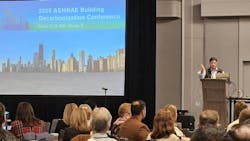Building Decarbonization Conference Stresses Strategic Engagement
Key Highlights
- Effective decarbonization planning involves understanding building systems, load profiles, and operational characteristics through detailed analysis and scenario planning;
- Stakeholder engagement, including facilities, operators, and financial decision-makers, is crucial for successful implementation and adoption of new technologies;
- Strategies such as thermal storage, heat recovery, and advanced heat pumps are key to beneficial electrification without exceeding peak electrical demand;
- Integrating buildings with the power grid via Virtual Power Plants and Demand Response can extend electrical capacity and support electrification efforts;
- Financial considerations, including incentives and potential fines, must be incorporated into planning, with early metering and retro-commissioning recommended for future decarbonization projects.
By NANCY KOHOUT, PE, LEED AP, BD+C
Senior Principal | Mechanical, SmithGroup
The latest ASHRAE Building Decarbonization Conference in Chicago this October highlighted that effective decarbonization planning requires a comprehensive understanding of building systems, plant load profiles, and operational characteristics.
Case studies presented during the conference demonstrated that each project brings unique challenges, often requiring detailed analysis and customized solutions. Decarbonization is frequently implemented in stages due to the limitations of current technologies and the constraints of existing building infrastructure.
A central theme throughout the conference was the importance of engaging all stakeholders in the process. This includes facilities and plant operators as well as financial decision-makers. Their involvement is essential for understanding the implications of proposed changes and for adopting new technologies and operational strategies. The planning process is typically iterative, involving technical analysis, simplified system design, financial modeling, and scenario planning. These efforts are translated into clear presentations that support informed decision-making and address anticipated stakeholder questions.
The ASHRAE and USGBC publication titled Guide to Strategic Decarbonization Planning (downloadable https://www.ashrae.org/about/cebd-technical-resources) is a free available resource. The innovative projects showcased at the conference demonstrated creative and diverse approaches to designing buildings and systems. The conference served as a catalyst for industry transformation and knowledge sharing, reinforcing the need for continued collaboration and innovation.
In addition to building-level strategies, the conference emphasized the importance of considering how buildings interact with the power grid. Sessions explored concepts such as Distributed Capacity Procurement, Virtual Power Plants, and Automated Demand Response. These strategies aim to support and extend the capacity of existing electrical infrastructure especially as power grid capacity is challenged to meet data center and electrification demands. A key concept introduced was beneficial electrification, which involves designing electrified heating systems that do not exceed a building’s current peak electrical demand, typically occurring during summer months. Achieving this goal requires consideration of a combination of strategies including envelope retrofits, thermal storage, heat recovery systems, advanced heat pump technologies, water source heat pumps served by geo-exchange or wastewater, and intelligent controls.
Financial considerations are a critical component of decarbonization planning. Stakeholders must understand not only the technical aspects but also the financial impacts, including federal, state, and local incentives. The potential consequences of escalating Building Performance Standard fines must also be incorporated. Scenario planning is essential to address the various questions and concerns clients may raise during the decision-making process.
Several key takeaways emerged from the conference:
- First, financial stakeholder engagement is necessary to ensure that decarbonization plans are feasible and actionable;
- Second, clients who anticipate pursuing decarbonization in the near future should begin metering, retro-commissioning, and thermal stress testing their buildings now;
- Third, aligning decarbonization efforts with existing capital renewal projects can significantly improve cost-effectiveness.
Finally, the engineering profession must embrace a paradigm shift that includes robust energy modeling. This involves using physics-based, data-driven, hybrid, and predictive models to analyze both annual and peak energy usage, as well as carbon emissions.
Decarbonization is a multidisciplinary challenge that blends engineering, financial strategy, stakeholder engagement, and policy awareness. It requires a fundamental shift in how buildings are designed, operated, and integrated with the broader energy ecosystem. The conference provided a valuable roadmap for professionals committed to reducing carbon emissions in the built environment.

